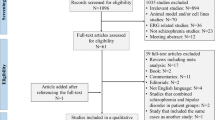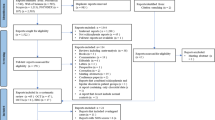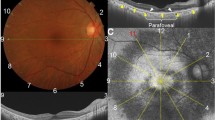Abstract
Purpose
To evaluate macular thickness profiles using spectral-domain optical coherence tomography (SDOCT) and image segmentation in patients with chronic exposure to hydroxychloroquine.
Methods
This study included eight patients with chronic exposure to hydroxychloroquine (group 1) and eight controls (group 2). Group 1 patients had no clinically evident retinal toxicity. All subjects underwent SDOCT imaging of the macula. An image segmentation technique was used to measure thickness of six retinal layers at 200 μm intervals. A mixed-effects model was used for multivariate analysis.
Results
By measuring total retinal thickness either at the central macular (2800 μm in diameter), the perifoveal region 1200-μm-width ring surrounding the central macula), or the overall macular area (5200 μm in diameter), there were no significant differences in the thickness between groups 1 and 2. On an image segmentation analysis, selective thinning of the inner plexiform+ganglion cell layers (P=0.021) was observed only in the perifoveal area of the patients in group 1 compared with that of group 2 by using the mixed-effects model analysis.
Conclusion
Our study results suggest that chronic exposure to hydroxychloroquine is associated with thinning of the perifoveal inner retinal layers, especially in the ganglion cell and inner plexiform layers, even in the absence of functional or structural clinical changes involving the photoreceptor or retinal pigment epithelial cell layers. This may be a contributing factor as the reason most patients who have early detectable signs of drug toxicity present with paracentral or pericentral scotomas.
Similar content being viewed by others
Log in or create a free account to read this content
Gain free access to this article, as well as selected content from this journal and more on nature.com
or
References
Rynes RI . Hydroxychloroquine treatment of rheumatoid arthritis. Am J Med 1988; 85: 18–22.
Wallace DJ . The use of chloroquine and hydroxychloroquine for non-infectious conditions other than rheumatoid arthritis or lupus: a critical review. Lupus 1996; 5 (Suppl 1): S59–S64.
Butler I . Retinopathy following the use of chloroquine and allied substances. Ophthalmologica 1965; 149: 204–208.
Levy GD, Munz SJ, Paschal J, Cohen HB, Pince KJ, Peterson T . Incidence of hydroxychloroquine retinopathy in 1,207 patients in a large multicenter outpatient practice. Arthritis Rheum 1997; 40: 1482–1486.
Mavrikakis I, Sfikakis PP, Mavrikakis E, Rougas K, Nikolaou A, Kostopoulos C et al. The incidence of irreversible retinal toxicity in patients treated with hydroxychloroquine: a reappraisal. Ophthalmology 2003; 110: 1321–1326.
Bernstein HN . Chloroquine ocular toxicity. Surv Ophthalmol 1967; 12: 415–447.
Marmor MF, Carr RE, Easterbrook M, Farjo AA, Mieler WF . Recommendations on screening for chloroquine and hydroxychloroquine retinopathy: a report by the American Academy of Ophthalmology. Ophthalmology 2002; 109: 1377–1382.
Easterbrook M . Long-term course of antimalarial maculopathy after cessation of treatment. Can J Ophthalmol 1992; 27: 237–239.
Penrose PJ, Tzekov RT, Sutter EE, Fu AD, Allen Jr AW, Fung WE et al. Multifocal electroretinography evaluation for early detection of retinal dysfunction in patients taking hydroxychloroquine. Retina 2003; 23: 503–512.
Rosenthal AR, Kolb H, Bergsma D, Huxsoll D, Hopkins JL . Chloroquine retinopathy in the rhesus monkey. Invest Ophthalmol Vis Sci 1978; 17: 1158–1175.
Hallberg A, Naeser P, Andersson A . Effects of long-term chloroquine exposure on the phospholipid metabolism in retina and pigment epithelium of the mouse. Acta Ophthalmol (Copenh) 1990; 68: 125–130.
Pasadhika S, Fishman GA . Effects of chronic exposure to hydroxychloroquine or chloroquine on inner retinal structures. Eye 2010; 24: 340–346.
Bagci AM, Shahidi M, Ansari R, Blair M, Blair NP, Zelkha R . Thickness profiles of retinal layers by optical coherence tomography image segmentation. Am J Ophthalmol 2008; 146: 679–687.
Vajaranant TS, Seiple W, Szlyk JP, Fishman GA . Detection using the multifocal electroretinogram of mosaic retinal dysfunction in carriers of X-linked retinitis pigmentosa. Ophthalmology 2002; 109: 560–568.
Ramsey MS, Fine BS . Chloroquine toxicity in the human eye. Histopathologic observations by electron microscopy. Am J Ophthalmol 1972; 73: 229–235.
Kellner U, Kellner S, Weinitz S . Chloroquine retinopathy: lipofuscin- and melanin-related fundus autofluorescence, optical coherence tomography and multifocal electroretinography. Doc Ophthalmol 2008; 116: 119–127.
Girkin CA . Relationship between structure of optic nerve/nerve fiber layer and functional measurements in glaucoma. Curr Opin Ophthalmol 2004; 15: 96–101.
Korah S, Kuriakose T . Optical coherence tomography in a patient with chloroquine-induced maculopathy. Indian J Ophthalmol 2008; 56: 511–513.
Rodriguez-Padilla JA, Hedges TR, Monson B, Srinivasan V, Wojtkowski M, Reichel E et al. High-speed ultra-high-resolution optical coherence tomography findings in hydroxychloroquine retinopathy. Arch Ophthalmol 2007; 125: 775–780.
Acknowledgements
We thank Ms Patricia Grant-Jordan from the Department of Ophthalmology, University of Illinois for her technical support on a multifocal electroretinographic procedure. This study was supported by Foundation Fighting Blindness, Owings Mills, Maryland, and Grant Healthcare Foundation, Chicago, Illinois (GAF); NIH core Grant EY01792; an unrestricted departmental grant from Research to Prevent Blindness; NIH Grant EY014275, Department of Veterans’ Administration, and Research to Prevent Blindness Senior Scientific Investigator Award (MS).
Author information
Authors and Affiliations
Corresponding author
Ethics declarations
Competing interests
The authors declare no conflict of interest.
Rights and permissions
About this article
Cite this article
Pasadhika, S., Fishman, G., Choi, D. et al. Selective thinning of the perifoveal inner retina as an early sign of hydroxychloroquine retinal toxicity. Eye 24, 756–763 (2010). https://doi.org/10.1038/eye.2010.21
Received:
Revised:
Accepted:
Published:
Issue date:
DOI: https://doi.org/10.1038/eye.2010.21
Keywords
This article is cited by
-
Outcomes of screening for hydroxychloroquine retinopathy at the Manchester Royal Eye Hospital: 2 years’ audit
Eye (2023)
-
Plasma homocysteine and macular thickness in older adults—the Rugao Longevity and Aging Study
Eye (2022)
-
Hydroxychloroquine Causes Early Inner Retinal Toxicity and Affects Autophagosome–Lysosomal Pathway and Sphingolipid Metabolism in the Retina
Molecular Neurobiology (2022)
-
Hydroxychloroquine retinopathy — implications of research advances for rheumatology care
Nature Reviews Rheumatology (2018)
-
Macular ganglion cell–inner plexiform layer thickness for detection of early retinal toxicity of hydroxychloroquine
International Ophthalmology (2018)



